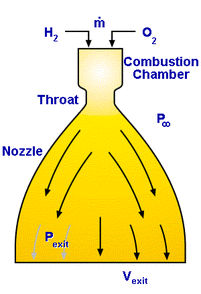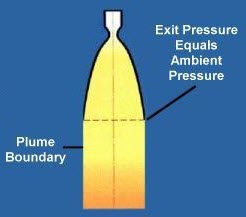# OVER-UNDER EXPANDED NOZZLE:
Table of Contents:
- What Are Over-Under Expanded Nozzle?
- Expansion Process
- Ideal Expanded Nozzle
- Over Expanded Nozzle
- Under Expanded Nozzle
What Are Over-Under Expanded Nozzle?
The over-under expanded nozzle is the condition of the nozzle where the exit pressure is greater or lower than the atmospheric pressure. Usually, the rocket (pumps and a combustion chamber) generates high pressure, a few hundred atmospheres. The nozzle turns the static high pressure high temperature gas into rapidly moving gas at near-ambient pressure.
Expansion Process:
Expansion is the process that converts the thermal energy of combustion into kinetic energy to move an object forward. In other words, the hot gases created by burning fuel inside a jet or rocket engine are exhausted through a nozzle to produce thrust. It is the shape of this nozzle that is key to the expansion process. As that high temperature flow is exhausted, it expands against the walls of the nozzle to create a force that pushes the vehicle forward.
Flow passing through a rocket nozzle

Ideal Expanded Nozzle:
- The behavior of this expansion process is largely dictated by pressure–both the pressure of the exhaust itself as well as the pressure of the external environment into which it exhausts.
- Of greatest concern is to design the shape and length of the nozzle so that it converts as much of that thermal energy into thrust as possible.
- In an ideal nozzle that optimizes performance, the exit pressure (Pexit) will be equal to the ambient pressure of the external atmosphere (P¥).
- The flow in this case is perfectly expanded inside the nozzle and maximizes thrust.
Unfortunately, this situation can only occur at one specific atmospheric pressure on a fixed-geometry nozzle. As we have seen previously, pressure decreases as altitude increases. Nozzle designers typically must select a shape that is optimum at only one altitude but minimizes the losses that occur at lower or higher altitudes. These losses result from the fact that the atmospheric pressure will either be higher than the exit pressure of the exhaust gases, i.e. at low altitudes, or lower than the exit pressure, i.e. at high altitudes.

Over Expanded Nozzle:
- This first case, where the external pressure is higher than the exit pressure, is referred to as overexpanded.
- When an overexpanded flow passes through a nozzle, the higher atmospheric pressure causes it to squeeze back inward and separate from the walls of the nozzle.
- This “pinching” of the flow reduces efficiency because that extra nozzle wall is wasted and does nothing to generate any additional thrust.
- Ideally, the nozzle should have been shorter to eliminate this unnecessary wall.

Under Expanded Nozzle:
- The opposite situation, in which the atmospheric pressure is lower than the exit pressure, is called underexpanded.
- In this case, the flow continues to expand outward after it has exited the nozzle.
- This behavior also reduces efficiency because that external expansion does not exert any force on the nozzle wall.
- This energy can therefore not be converted into thrust and is lost.
- Ideally, the nozzle should have been longer to capture this expansion and convert it into thrust.

